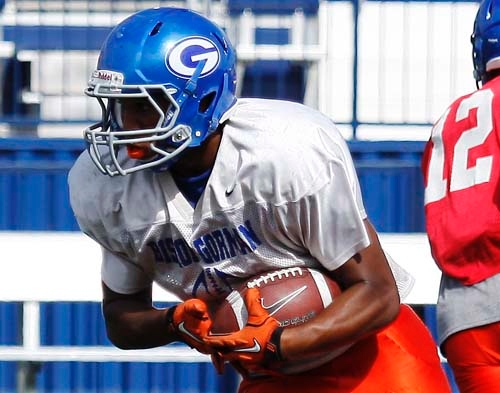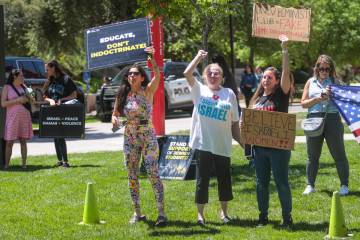Bishop Gorman: Private school’s sports dominance threatens alliance
When the Nevada Interscholastic Activities Association's board of control holds its summer meeting Monday and Tuesday at The Orleans, its agenda runs the gamut from the pledge of allegiance and regular reports to action items on new member schools and liability insurance.
At some point during those two days, however, the body that governs the state's high school sports is likely to acknowledge the 500-pound gorilla in the room and move to a continuing discussion of the question that has perplexed the NIAA and many of its large member schools and their fans for the better part of the past decade:
What to do with Bishop Gorman?
Yes, the Gaels, the private school and sports juggernaut, nationally ranked more often than not; seven straight Nevada baseball crowns, three boys basketball championships in the past four years, and four of the five most recent large-school football titles - the last one a 72-28 mauling of northern power Reed High School of Sparks in the 2011 championship game.
This week's NIAA meeting promises neither fireworks nor decisions. The board will hear a report on the subject of private-public school participation and may visit the subject at some point in a scheduled executive session to discuss legal matters.
The latter became more likely when the NIAA this spring indicated it might consider a way to allow the school to play regular-season games against the state's public schools but bar it from competing for state championships.
Gorman responded with a lawyer, and with demands for all NIAA records and communications concerning the issue of the school's continued participation in Nevada's interscholastic sports championships.
Representatives of Gorman, NIAA and/or the Clark County School District have held several closed-door meetings since then. Early Friday morning, at the Clark County School Board meeting, Carolyn Edwards, a member of both that board and the NIAA, revealed that Gorman officials put an offer on the table at a June 13 meeting between Gorman and district officials.
Edwards said that Gorman had three key demands:
■ It will not give up the opportunity to qualify for and play in state championships, which some public schools have wanted.
■ The school district must guarantee that its schools will not forfeit scheduled games, which some public high school principals have threatened.
■ District schools will continue to schedule nonleague games with Gorman.
Among "other things," Edwards said, Gorman in return would assure the district that the school would not recruit student-athletes. She did not expand on what other considerations or concessions the private school might be willing to make.
"It's a big, tall order" that Clark County high school principals will have to consider at a meeting this summer, Edwards said.
There are good reasons why Gorman is talking directly with local school officials.
The district represents more than two-thirds of the state's students and has lots of dogs in this fight. And, in 2006, it seriously considered pulling its schools from the NIAA to form its own league.
Ironically, that was even before Gorman went on its mostly unabated run of state football, basketball and baseball titles.
The district abandoned that position when an agreement was reached with some stipulations. Principals must inform coaches that they are "strictly prohibited" from attending public middle school sports events. Doing so would be viewed as "illegal recruitment." And, no student-athlete's tuition could be paid by someone other than the family, meaning a booster or host parents couldn't help pay their way. Players and their parents had to sign a form acknowledging this rule, and breaking it would result in athletic ineligibility.
Private schools can provide scholarships as long as student-athletes don't receive more than is "made available to each pupil who enrolls in or applies" to the school, according to state law.
Six years and many state championships later, however, Gorman is back in the cross hairs.
County school Superintendent Dwight Jones said the district hopes "cooler heads will prevail" again.
He realizes the legal hurdle in demanding the same transparency for private and public schools, but said that if NIAA doesn't make a substantial change, the district would be forced to consider its options:
"We would be wrong to dismiss this."
■ ■ ■
In 2006, the school board reacted to what it said were long-standing suspicions of "potential" recruiting and excessive tuition assistance at Gorman, recalled Edwards.
"I use the word 'potential' very carefully," said Edwards, because the NIAA hasn't seen any proof.
This spring, NIAA formed a subcommittee to look at Gorman's continued participation in championship playoffs. Gorman refused to take part, saying the composition of the group predetermined an adverse outcome.
"Bishop Gorman's refusal to participate is unfortunate, but I also think it's strategic," Edwards said.
The NIAA does not require any documentation from Gorman or other private schools about tuition assistance per athlete, and the state association is hesitant to test whether it legally can.
"They (Bishop Gorman) have the ability to pay lawyers that NIAA can't match," Edwards said.
The NIAA acts under power granted by the state, but it receives no direct state funding, operating as an independent nonprofit with a $1.5 million annual budget that comes from member schools, partnerships and sponsorships (including the Las Vegas Review-Journal), and state tournament admission fees. About $85,000 is available for legal expenses, according to NIAA's most recent IRS report for 2010.
Despite Gorman's refusal to join the subcommittee, multiple sources said there have been "productive" informal discussions between representatives of the school and the NIAA. One source said that the sides seem to have a better understanding of opposing viewpoints.
The Clark County School Board hasn't discussed secession again, and won't consider any action until it hears the suggested solution of the NIAA sub-committee, all board members agreed in separate interviews.
"Truly, I don't know what the answer is," school board member Chris Garvey said. "But we need to wait for the NIAA."
One big difference between the two battles over Gorman? This time, it's not just Clark County's public schools fighting for transparency.
"North schools have joined the fight," said Paul Anderson, NIAA attorney for nearly two decades, "creating a perfect storm."
■ ■ ■
The signed forms called for in the 2006 agreement haven't put recruiting suspicions to rest or opened Gorman's books to prove that players aren't receiving more tuition assistance than other students, said Anderson.
"For a while, the forms worked," he said. "Things have now gone back the other way, hitting the fan again."
And since NIAA may not have the authority to demand financial records from private schools if it tried, how can it know whether the rules are being followed?
"That's the very valuable question. We don't know," said NIAA executive director Eddie Bonine. "What they do inside their school, we don't know."
All the NIAA has are rumors.
Ray Mathis, Clark County School District's executive athletic director, said there's an easy answer: "Private schools have to make an effort to be as transparent as possible.
"I think what the public school people want is for Gorman to step up and say, we can control these things, and we're going to do everything possible to show you what takes place at this school. The schools just want transparency to make sure Gorman is doing everything it is supposed to do."
In early May, the Review-Journal sent questionnaires to Bishop Gorman and Faith Lutheran about their tuition assistance programs.
Among the questions:
■ How many students receive some form of tuition reduction or financial aid from the school, what is the range of that aid, and what is the average amount of aid for students receiving such?
■ What percentage of students participating in NIAA-sanctioned sports receives some form of financial aid or tuition reduction?
■ What percentage of students participating in boys football, basketball and baseball, and girls basketball, soccer and volleyball receive some form of financial assistance or tuition reduction?
■ What is the average amount of financial aid or tuition reduction provided to participants in each of the above-named sports?
Neither school responded to the newspaper.
Faith Lutheran President Steven Buuck said he began to fill out the questionnaire but decided against it after learning Gorman would not reply. Buuck said he knew the survey wouldn't be a complete view of large private schools and didn't want Faith Lutheran singled out.
"I've spoken publicly many times about the amount of aid we give out, and I have no problem opening our books to anyone who would like to see them."
Buuck has been open about Faith Lutheran's financial aid process, spelling out much of it during a NIAA committee meeting on May 2 at South Point. He said the most tuition assistance Faith Lutheran provided any student during the 2011-12 school year was a 36 percent reduction. That number will drop this year to 30 percent.
Faith Lutheran's tuition is expected to be $9,700 next year, plus nearly $1,000 in fees for registration, books and materials.
Calls to Gorman President John Kilduff were not returned, but the school has posted a $12,100 basic tuition for next school year, plus $1,400 in fees. The school's website says that 40 percent of its students receive some type of financial assistance, and Gorman insists that athletic participation is not a factor in determining such aid.
"This is the most important decision (Gorman) will make, to be transparent or not," Mathis said. "If they show people what they do and how they do it, that's how this goes away."
■ ■ ■
The Clark County School District hasn't exactly been transparent itself.
Athletes often transfer from one public school to another, gaining eligibility in ways that don't always seem to be on the level. And allegations of recruiting among public high school coaches have existed for decades. That leaves some principals shaking their heads as the rumor mill churns about how a student zoned for their school is suddenly competing for a rival.
"I believe the CCSD has issues that we're not bringing to the table," Las Vegas High Principal Debbie Brockett said during a NIAA committee meeting in May. "Maybe there wouldn't be the inequalities if we weren't picking kids from our own schools. It's brought to light that there are far too many rumors."
The Clark County School District also has magnet schools, which offer unique areas of study, and several district schools offer open enrollment, allowing students from anywhere within the district to apply to attend classes at schools for which they are not zoned.
In both of those cases, an athlete who attends the school is immediately eligible to compete.
"The district does that to balance out the schools," Mathis said. "Kids want to go to the brand new buildings. The district put the magnet programs in place to bring kids to some of the older schools."
Open enrollment is a newer concept but fills the same role, trying to better balance the number of students at the schools.
Schools post open seats, and any Clark County student may apply for them.
"It's not recruiting for athletic purposes," Mathis said.
It's also not a chance for students to school jump. If a student chooses to attend a magnet school or opts for open enrollment, then wants to transfer back to his zoned school, he must sit out of athletic competition for 180 school days.
The NIAA has also worked to close some loopholes involving the transfer to magnet schools, adding a provision to its rules late last year that allows students who transfer to the magnet to be eligible to play only if it's possible for them to complete the magnet program.
■ ■ ■
If Clark County's high school athletes have more freedom through open enrollment and their own loopholes, why are targets again fixed on Gorman like in 2006?
The simple answer: the 2011 4A State Football Championship game.
The outcome reignited the fire with public school principals, adding northern Nevada schools to the chorus demanding change. Northern schools previously watched the war with Gorman from afar.
But last Dec. 3, Gorman's pummeling of Reed High School was Northern Nevada's Pearl Harbor, bringing its call to arms.
"They dominated," said NIAA board member and Washoe County School District Board President Ken Grein. "And this was the best football team Reed ever had. I saw a Gorman line that belonged on a university field."
Gorman's ability to field the biggest, fastest players raised suspicions among northern high school principals that had long been present in Southern Nevada, he said.
"The north schools got to see what Clark County schools see on a daily basis," said NIAA lawyer Anderson.
Edwards, who sits on both Clark County and NIAA boards, says that despite the rumors and speculation, no one has provided any proof of any Gorman misdeeds.
And until any are proven, she doesn't have a position.
Except for one thing.
"I have no sympathy for schools that lose and say, 'We can't win. We should kick them out,' " she said. "If it's simply because Gorman is winning all the time, that's not a good reason."
Contact reporter Trevon Milliard at tmilliard@reviewjournal.com or 702-383-0279. Contact reporter Bartt Davis at bdavis@reviewjournal.com or 702-387-5230.
In-depth high school sports coverage




























